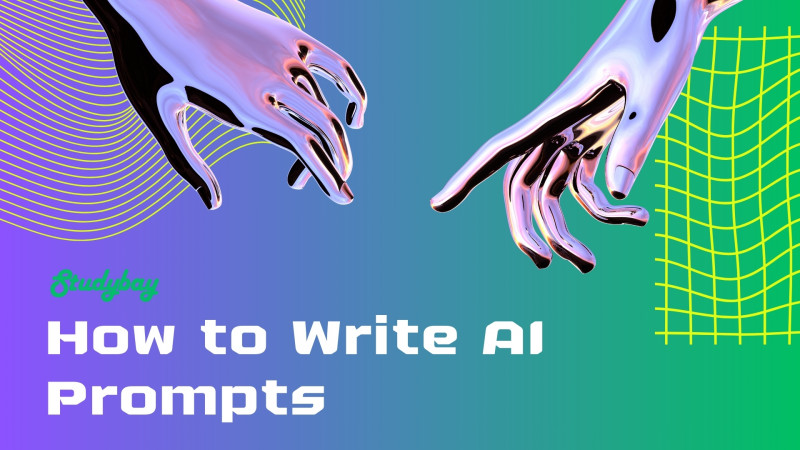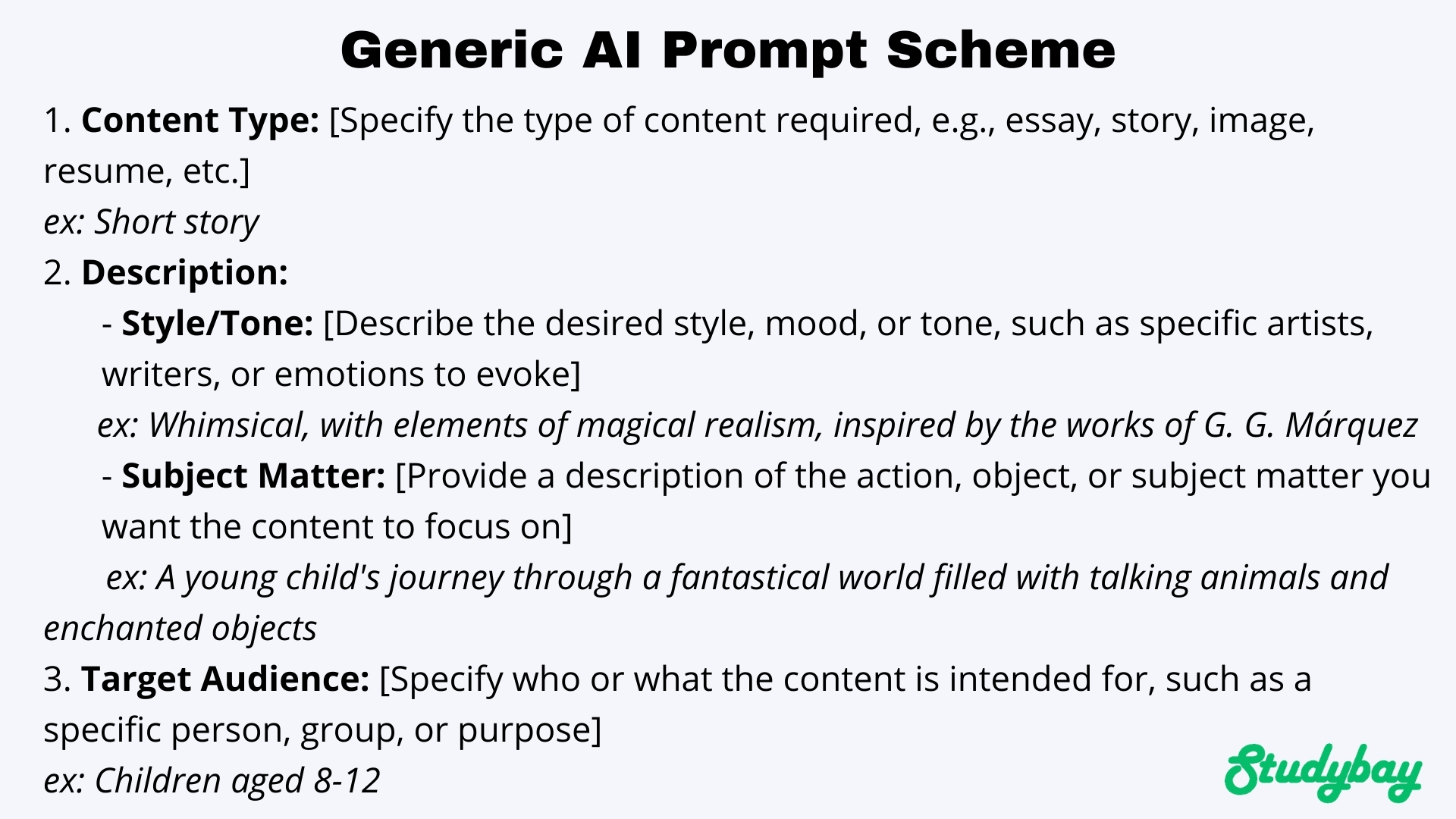
16 min
0
03.13.2024

When using AI for assistance, it makes sense that the better the prompt, the better the result produced. However, it can be difficult to come up with efficient prompts to get across what you’d like the AI to generate. Keep reading to learn hints and tips on how to write good AI prompts to optimize outputs. Ultimately, this will save time and energy, allowing you to generate even more content or just get your answer faster.
AI Writing Prompts Defined
A prompt is the instruction given to AI by a user. Essentially, it is the way that the user and the AI interact. Prompts tell the artificial intelligence what to do and how to do it – for example, write in a certain style or from a certain viewpoint. It’s important to remember that AI is a machine and may not fully grasp nuance or ambiguity. So, it’s vital to be clear when giving a prompt so that the algorithm can give an optimal output. Writing AI prompts can certainly come with its challenges, but once you get the hang of it, prompting AI will become much easier.
AI Writing Prompts Explained
Prompts should be structured in a way that gives crucial information to AI without overcomplicating the instruction. Only vital information should be given. AI prompt writing should first include the type of content required. This could be an essay, a story, an image, a resume, or something else. Next, provide a description of what you require. This might be suggested styles of artists or writers, what mood or tone you want the piece to have, or a description of an action or object. Finally, it’s important to include who or what the drawing or text is for.

How to Write Effective AI Prompts
By using the guidance below, you can improve the instructions you give the AI and produce a result that is a much more accurate representation of what you need. These AI prompt tips will greatly assist in learning to build an efficient and effective prompt.
Establish Your Goal
For a successful prompt, it’s important to first identify what kind of result you’re expecting. Whether it’s rewriting your resume or generating a work of art, telling the tool what you want is key in how to write good prompts for AI.
Be Specific
Specificity is crucial when giving AI a prompt. AI cannot read minds or read between the lines, so being exact helps the algorithm generate exactly what is asked. For example, “Give me suggestions on marketing” vs. “give me a bullet-point list of how I can improve my marketing campaign for chocolate.” The more specific you are, the more exact the output will be. When looking for how to prompt AI, specificity should be the first thing on your mind. This allows the AI to know exactly what information to gather and what resources to pull from in its learned database.
Review Your Grammar and Spelling
While most AI can look past simple spelling errors, any issues with grammar or complex spelling issues can result in confusion. This comes back to the AI’s incapability to distinguish between ambiguous text, which can ultimately affect the final output. Additionally, asking an AI tool to review your spelling and grammar within a piece of text may result in missed errors, which humans could instantly pick up on. Great AI prompts are clear and concise, with little room for misinterpretation. Any grammar or spelling issues can end up with an output that does not match what you are looking for.
Include Context
AI prompt help includes adding context. For some tasks, more information may be helpful to the algorithm. For example, if asking the AI to help with your resume, you could request that it be tailored to a specific job role. Or, if you are looking for help with your novel, giving it information about characters and plotlines can help the tool fill in any gaps, giving a personalized response over a generic one. As an example, you could try “My story is about a dog learning to bark. Please suggest some useful plot points to help convey a message of kindness to children.” If there is a lot of context to give, you could write this out in a separate file before copy-pasting it into the tool.
Ask for an Identity or Profession
Asking an AI to review your work is a way of testing it before releasing it to its intended audience. For example, you could ask the tool to review the text from a student’s perspective. Then, it would provide suggestions and feedback from their point of view. Another example could be to ask the algorithm to take on the role of an interviewer, giving a simulation of an interview for practice. Or, the AI could give you the perspective of a career advisor based on the skills and experience you have or want to obtain. As it is trained on an enormous database of text and information, the AI can give relatively good guidance based on what the input is.
Check the Tool’s Capabilities
An important action for any user is to check the guidance for the tool being used. This gives details on the tool’s capabilities. It may also provide inspiration. Additionally, there will be information on all the features it can provide. Some tools may also have an AI prompt guide to help you make the most of the program. Others may have suggested prompts that change every time you open the tool, meaning you’ll never be short of ideas or ways to guide the system.
Define the Form and Style
If you’re looking to learn how to write AI prompts for art, when generating an image, the AI will need information on what style to emulate. This could also apply to asking the AI to write a story in the style of a specific author. For example, “write a sonnet about flowers in the style of Shakespeare” or “generate a painting of a car in the style of Van Gogh.”
Explore Different Prompts
Users should never be afraid to experiment with prompts. Perhaps the AI didn’t give exactly what you were looking for, or there weren’t enough details. You could try different wording or a new prompt altogether. For example, “generate an image of a cat” could be changed to “generate an image of a realistic kitten wearing a bow tie.” Learning how to write better AI prompts comes with practice and experience. Only with experimentation will you learn the patterns that work best with the tool you’re using. The AI will respond differently to different prompts, and with experimentation, you can explore much of the algorithm’s capacity.
Another bonus to experimenting with AI prompts is that it encourages you to think creatively and outside the box. You might also uncover new inspiration and information on topics that would never have occurred to you otherwise.
How to Write Effective Prompts for AI: More Tips
Below are some more tips you can use as a prompt guide when using an AI tool.
- Asking for cited resources. Including this in your prompt writing AI learning means the information given to you will be based on facts and scholarly articles.
- Asking open-ended questions. This allows the AI to draw from its knowledge fully and use its capacity to adequately approach your request rather than providing a yes or no answer.
- Using descriptive words. The description adds more information for the AI to work with. This is also one of the most useful AI art prompt tips when asking for image generation.

- Repeating back an original request. This ensures the AI understands your commands and requests.
AI Prompt Templates
Below are some templates for prompts that set examples of clear and precise instructions. They are loosely based on the AI prompt template of [type of work] + [audience] + [description of what you want to generate]. This is also a good structure to use overall, as it gives enough information to the tool. Remember that when using an AI art template, the information really needs to be as detailed as possible to produce the type of visual you want.
Social media prompts:
- “Generate an inspirational quote for first-time marathon runners to help them get motivated.”
- “Write a how-to post for beginners wanting to make sourdough bread.”
- “Write a list of five interesting facts about the ocean for my followers.”
Writing prompts:
- “Write a blog-style post for my gen Z Facebook followers about learning to be kind to themselves.”
- “Write a script for my child audience on YouTube telling a story about sharing.”
- “Write a book for children about Christmas.”
Drafting prompts:
- “Draft a PowerPoint presentation for middle schoolers about the solar system.”
- “Structure a meeting for my employees about staff conduct.”
- “Draft the abstract of my university paper about architecture in the mid-20th century.”
Editing prompts:
- “Edit my essay about contract law to make it readable for university students.”
- “Edit my resume for hiring staff so I can get an IT job.”
- “Edit my novel so it’s more readable for the average person.”
Reviewing prompts:
- “Review my resume for spelling and grammar errors.”
- “Review my speech about environmental problems to make it appropriate for university students.”
- “Review my blog post from the perspective of an expert in aromatherapy.”
Creating images:
- “Generate an image of a realistic flower diagram for children.”
- “Create a picture for my phone wallpaper of a dog playing with a ball in the grass.”
- “Generate an image for a ski-themed party of mountains and snow.”
Limitations of AI
While AI is popular right now, it’s important to remember that it does not have the same capacity as human beings. It is also dependent on the quality of the data it’s trained on. Furthermore, AI does not hold any concern over ethics and is also incapable of empathy and understanding of true human creativity.
That’s why we recommend entrusting your education to the professionals available on Studybay, who can better understand context and nuance and bring that human touch to any task given.
Conclusion
In conclusion, it’s clear that you get out of AI what you put in. Prompts should be clear, concise, detailed, and simple. Making use of the tips provided in this article will definitely help you save precious time trying to get good results from an AI tool. Remember that AI still has its limitations, so you might consider using Studybay’s expert humans for help instead. Overall, it can be difficult to find the right balance. However, practice and experimentation will ultimately result in gaining more experience in writing efficient prompts to unlock AI tools’ potential.
List of Resources
-
Getting started with prompts for text-based generative AI Tools. Getting started with prompts for text-based Generative AI tools. (2023, August 30). https://huit.harvard.edu/news/ai-prompts
-
Gewirtz, D. How to write better CHATGPT prompts in 5 steps. ZDNET. https://www.zdnet.com/article/how-to-write-better-chatgpt-prompts-in-5-steps/
-
Krantz, M. (2023, December 8). How to write great AI prompts. Notion. https://www.notion.so/blog/how-to-write-ai-prompts
-
HarpOnLife. (2023, November 11). The art of AI PROMPT CRAFTING: A comprehensive guide for enthusiasts. OpenAI Developer Forum. https://community.openai.com/t/the-art-of-ai-prompt-crafting-a-comprehensive-guide-for-enthusiasts/495144
FAQ
What is the definition of an AI prompt?
How to write prompts for AI?
How to use AI prompts?
Is it important to learn how to write prompts for AI?
How can I learn how to write an AI prompt?
Can you tell me how to write prompts for AI art generators?
What tips for AI art prompts are there?



